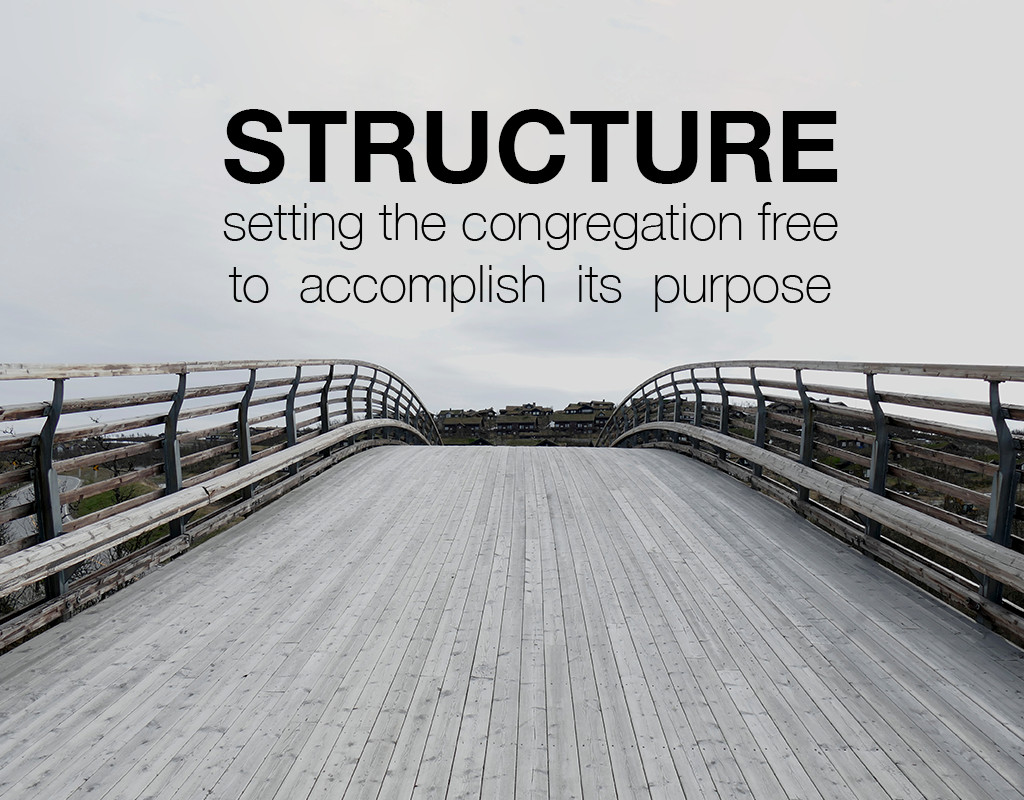I often hear pastors and lay leaders talk about frustrations related to their church’s organizational structure. As we unpack their situation, it becomes apparent they don’t feel like the structural model is working very well. It has become a lid to health and missional effectiveness. This happens to a lot of congregations.
I was blessed to pastor the same church for the initial 25 years of my ministry. The first year I was trying to figure out how the church’s structure operated. The next few years I was dealing with the limitations and misfires of that structure. The last 18 years were a lot more fun and effective as we transitioned to a new structure.
I once had the good fortune of joining some ministry leaders for lunch with pastor, Christian leader, and consultant Leith Anderson. At one point our conversation turned to church structure. I’ll never forget what he said.
“The purpose of structure is to free the organization to accomplish its mission.”
 That was a new idea to me. But it rang true!
That was a new idea to me. But it rang true!
Just for the record – I’m not one of those people who love to talk endlessly about organizational structure. What makes my heartbeat rapidly is a church accomplishing its mission of making more and better disciples. I long for structure that sets the church free to accomplish its purpose.
Understanding Structure as a Lid
When a church’s structure is its lid to ministry effectiveness, one or more of the following symptoms repeatedly surfaces.
- There is no vision or, as is usually the case, there are too many visions. This is a very common problem in churches today. It happens when there has been a lack of vision from the pastor and church leadership. People (board members, staff members, and congregational members) develop their own visions and begin pursuing them. When this happens the structure gets hijacked and manipulated. An effective structure unifies vision casting so that the congregation moves forward together.
- The primary board spends much of its time in the weeds. Details do need attention. Someone needs to be responsible for managing the budget, maintaining the facility, and taking care of the nuts and bolts that make an organization run smoothly. But when the primary board gets bogged down in the weeds, any church will get derailed from its mission. The structure needs to free the primary board to focus on the big picture of mission accomplishment.
- Lack of accountability. Though Christian leaders talk a lot about accountability, most churches struggle to provide it. When accountability is provided, it is often rooted in the personal whims and preferences of the strongest personality on the board or in the church. Structure alone cannot provide accountability, but it can certainly hinder it. The structure needs to establish a basis for accountability that contributes to mission accomplishment.
- Lack of empowering authority. Pastors often have the responsibility of leading the church but aren’t given the corresponding authority to lead effectively and directionally. Any functional structure empowers the primary leader (senior pastor) to lead. If it doesn’t, it is a lid and needs to be addressed.
- Board members (or staff) are sending conflicting messages to the church rather than speaking with one voice. I’ve been in too many church business meetings where one or more persons on the board disagrees openly with a decision the board made or speaks against a motion the board has recommended to the congregation. That almost immediately defeats any recommended action. And it violates one of the basic best practices that every board should follow. Namely, board disagreement is welcome during the discussion phase but once a decision is made each person on the board must support it as though it was his or her idea. The structure needs to ensure that the board (or staff) speaks with one voice or there will be confusion and division in the church.
- Appropriate boundaries are ignored or are nonexistent. If the structure (either bylaws or policies) doesn’t identify boundaries, then each person does what seems right to him or her. This results in structural chaos and tension, and the enemy of our souls often uses it to derail a church from its mission. The structure needs to provide the means for establishing and enforcing appropriate boundaries.
Where To Get Help
If your church’s structure evidences any of the above symptoms, there is a good chance it is a lid to the church’s missional effectiveness. The good news is that structures can be changed! I know that sounds scary, but it doesn’t need to be. Changing the structure can actually be invigorating and unifying, especially if you have someone lead you through the change process and provide training in how a new structure should operate. If you need help assessing and/or making changes, contact Tom Planck.
 Post contributed by Doug Talley, Executive State Pastor of Indiana Ministries of the Church of God. Doug’s pastoral experience includes serving over 25 years as lead pastor of Westlake Community Church in Indianapolis, Indiana. He graduated from Anderson University and Anderson School of Theology. Doug has his doctorate from Fuller Theological Seminary in Pasadena, California. Doug resides in the Indianapolis area with his wife Cindy. They have two sons and four grandchildren.
Post contributed by Doug Talley, Executive State Pastor of Indiana Ministries of the Church of God. Doug’s pastoral experience includes serving over 25 years as lead pastor of Westlake Community Church in Indianapolis, Indiana. He graduated from Anderson University and Anderson School of Theology. Doug has his doctorate from Fuller Theological Seminary in Pasadena, California. Doug resides in the Indianapolis area with his wife Cindy. They have two sons and four grandchildren.


